(H.-U. Hecker, D. Mühlhoff, A. Steveling, Introduction Set out below are examples of treatments for major illnesses encountered in everyday practice and which respond to auricular acupuncture. These examples take into account points according to the Chinese school and points according to Nogier. To a far greater extent than body acupuncture, auricular acupuncture is a mixture of points The beginner will initially restrict himself/herself to the points of the somatope (a lung disease is treated via the Lung Point; a disease of the Lumbar Vertebrae Zone [LVZ] is treated in the LVZ section in the auricula) and to the points according to Western pathophysiological findings (an allergic illness is treated via the ACTH Point or the Adrenal Gland Point to exert an influence on glucocorticoid metabolism or to promote adrenergic hormonal influence). From a traditional Chinese viewpoint, the advanced student will select points which relate, for example, to the Theory of Five Elements. Thus, arterial hypertension can be treated pragmatically in the blood pressure–reduction furrow but, according to the TCM perspective, regulated via the Liver Point (stores the blood, regulates excessive liver yang) and Heart Point (moves the blood). The selection of Nogier points is always individual to the patient depending on the acute findings (active auricular acupuncture points). Experience shows that the additional auricular acupuncture points specified according to Nogier can frequently be found as active auricular acupuncture points in the corresponding illnesses. However, it should be pointed out once again that auricular acupuncture points should not be used rigidly according to predetermined point combinations but according to the examination findings based on active points. Nonetheless, it is a useful aid for the beginner to use the predetermined points as a guide. Internal and Psychosomatic Disorders (D. Mühlhoff, H.-U. Hecker) Acupuncture or auricular acupuncture can be a supportive treatment option in treating psychosomatic illnesses. Fixed treatment programs cannot be specified, though. The corresponding complaints form the basis for point selection, with individual circumstances being taken into account. Treatment of Pollinosis Points According to Chinese Nomenclature 13 Adrenal Gland Point 14 External Nose Point 16 Inner Nose Point 17 Endocrine Point 23 Ovary Point 30 Parotid Gland Point 51 Vegetative Point 55 Shen men 71 Urticaria Zone 78 Apex of Ear Point 100 Heart Zone 101 Lung Zone 102 Bronchial Zone 103 Trachea Zone Points According to Nogier and Bahr Allergy Point (= Chinese Point 78 [Apex of Ear Point], possibly microphlebotomy) Nose Point Sneezing Point Occiput Point Interferon Point Thymus Gland Point ACTH Point Diseases of the Respiratory Tract Points According to Chinese Nomenclature 12 Apex of Tragus Point 13 Adrenal Gland Point 15 Larynx Point 16 Inner Nose Point 22 Endocrine Point 31 Asthma Point 42 Thorax Point 51 Vegetative Point 55 Shen men 60 Dyspnea Point 91 Large Intestine Point 95 Kidney, Adrenal Gland Point (functional) 101 Lung Zone 102 Bronchial Zone Points According to Nogier and Bahr Bronchopulmonary Plexus Point Point Zero Stellate Ganglion Point ACTH Point Thymus Gland Point Interferon Point Allergy Point (= Chinese Point 78 [Apex of Ear Point]) Beta 2 Receptor Point Occiput Point Temporomandibular Joint Point Omega Points Thalamus Point Frequently Found Point Combinations in Disorders of the Respiratory Tract Asthma 22 Endocrine Point 31 Asthma Point 51 Vegetative Point 55 Shen men 60 Dyspnea Point 101 Lung Zone ……. Allergy Point ACTH Point Thymus Gland Point Irritated Vertebral Segment Point Stellate Ganglion Point Frontal Sinus Point (mucous membranes) Maxillary Sinus Point (mucous membranes) Bronchitis 13 Adrenal Gland Point 29 Occiput Point 51 Vegetative Point 55 Shen men 101 Lung Zone 102 Bronchial Zone Sinusitis 13 Adrenal Gland Point 16 Inner Nose Point 22 Endocrine Point 101 Lung Zone ……. Frontal Sinus Point (mucous membranes) Maxillary Sinus Point (mucous membranes) ACTH Point Allergy Point Frontal Bone Point Allergic Rhinitis 13 Adrenal Gland Point 16 Inner Nose Point 22 Endocrine Point 23 Ovary Point ……. Allergy Point ACTH Point Rhinitis sicca 13 Adrenal Gland Point 16 Inner Nose Point 33 Forehead Point 98 Spleen Zone 101 Lung Zone ……. Frontal Sinus Point (mucous membranes) Maxillary Sinus Point (mucous membranes) Pain in the Chest 29 Occiput Point 42 Thorax Point 55 Shen men 101 Lung Zone ……. First Rib Point Stellate Ganglion Point Irritated Vertebral Segment Point Temporomandibular Joint Point Cardiovascular Diseases Points According to Chinese Nomenclature 13 Adrenal Gland Point 19 Hypertonus Point 34 Gray Substance Point 51 Vegetative Point 55 Shen men 59 Blood Pressure–Reduction Point 95 Kidney, Adrenal Gland Point (functional) 97 Liver Zone 98 Spleen Zone 100 Heart Zone 105 Blood Pressure–Reduction Furrow (rear side of the auricula, cf. p. 135) Points According to Nogier and Bahr Thalamus Point Master Omega Point Antiaggression Point 29 b Jerome Point Cardiac Plexus Point Point Zero Beta 1 Receptor Point Renin/Angiotensin Point Irritated Vertebral Segment Point First Rib Point Stellate Ganglion Point Heart Point Frequently Found Point Combinations in Diseases of the Cardiovascular System Hypertension 19 Hypertension Point 51 Vegetative Point 55 Shen men 95 Kidney Zone 97 Liver Zone 100 Heart Point ……. Antiaggression Point Cardiac Plexus Point 29 b Jerome Point Beta 1 Receptor Point Thalamus Point Renin/Angiotensin Point Hypotension 13 Adrenal Gland Point 34 Gray Substance Point 100 Heart Point ……. Renin/Angiotensin Point Heart Point Heart Rhythm Disturbances 29 Occiput Point 29 b Jerome Point 51 Vegetative Point 55 Shen men 100 Heart Point ……. Irritated Vertebral Segment Point Stellate Ganglion Point First Rib Point Antiaggression Point Cardiac Plexus Point Angina Pectoris 42 Thorax Point 51 Vegetative Point 55 Shen men 100 Heart Point ……. Irritated Vertebral Segment Point 29 Occiput Point Diseases of the Digestive Organs Points According to Chinese Nomenclature 9 Inner Ear Point 22 Endocrine Point 34 Gray Substance Point 51 Vegetative Point 55 Shen men 81 Rectum Point 82 Diaphragm Point 85 Esophagus Point 86 Cardia 87 Stomach Point 88 Duodenum Point 89 Small Intestine Point 91 Large Intestine Point 96 Pancreas and Gallbladder Zone 97 Liver Zone 98 Spleen Zone 100 Heart Zone Points According to Nogier Irritated Vertebral Segment Point Antiaggression Point 29 Occiput Point 29 a Kinetosis and Nausea Point 29 b Jerome Point Diaphragm Point Solar Plexus Zone Anxiety Point Vegetative Point II Hypogastric Plexus Point (= Omega 1) Anus Point (External and Internal) Oppression Point (= Anxiety Point 2) Allergy Point Zones of corresponding internal organs ACTH Point Frequently Found Point Combinations in Diseases of the Digestive Organs Functional Gastrointestinal Singultus Colitis Complaints 51 Vegetative Point 55 Shen men 87 Stomach Point 89 Small Intestine Point 91 Large Intestine Point 100 Heart Zone ……. 29 Occiput Point 29 b Jerome Point Antiaggression Point Nausea, Sickness 9 Inner Ear Point 29 Occiput Point 51 Vegetative Point 55 Shen men 82 Diaphragm Point 87 Stomach Point ……. 29 a Kinetosis and Nausea Point Diaphragm Point Solar Plexus Zone Colic-like Complaints 51 Vegetative Point 55 Shen men 82 Diaphragm Point 89 Small Intestine Point 91 Large Intestine Point ……. Hypogastric Plexus Point Irritated Vertebral Segment Point 29 b Jerome Point Diaphragm Point Singultus 34 Gray Substance Point 51 Vegetative Point 55 Shen men 82 Diaphragm Point ……. Irritated Vertebral Segment Point Diaphragm Point Dyspepsia 22 Endocrine Point 89 Small Intestine Point 97 Liver Zone 98 Spleen Zone Anal Pruritus 22 Endocrine Point 30 Parotid Gland Point 34 Gray Substance Point ……. Allergy Point Anus Point (External and Internal) Rectum Point Hemorrhoid Point ACTH Point Antiaggression Point Colitis 29 Occiput Point 34 Gray Substance Point 55 Shen men 87 Stomach Point 89 Small Intestine Point 91 Large Intestine Point 100 Heart Zone ……. Allergy Point ACTH Point Antiaggression Point Oppression Point Vegetative Point II Constipation 55 Shen men 81 Rectum Point 89 Small Intestine Point 91 Large Intestine Point Diarrhea 55 Shen men 89 Small Intestine Point 91 Large Intestine Point 98 Spleen Zone Psychosomatic Disorders Points According to Chinese Nomenclature 25 Brain Stem Point 26 a Pituitary Gland Point 34 Gray Substance Point 51 Vegetative Point 55 Shen men 100 Heart Point Points According to Nogier and Bahr Vegetative Point II Points on the postantitragal fossa (Line: Point 29a, Kinetosis and Nausea Point–Point 29, Occiput Point–Point 29b, Jerome Point–Point 29c, Craving Point) Antidepression Point Antiaggression Point Anxiety Point Anxiety Point 2 (Oppression Point) Joy Point, Sorrow Point Omega Points (1, 2, Master Point) Point R (according to R.J. Bourdiol) Thalamus Point (= Chinese 26a [Pituitary Gland Point]) Valium Analogue Point Barbiturate Analogue Point Frustration Point Explanations of the Points Used Points According to Chinese Nomenclature 25 Brain Stem Point Location: At the intersection of the antitragus and the anthelix, slightly nearer the antitragus. Indication: Meningeal irritations, child development problems, consequences of concussion. 26a Pituitary Gland Point (Thalamus Point According to Nogier) Location: Corresponds on the inside to the location of Point 35 (Sun Point), in the middle of the base of the antitragus. Indication: A general analgesic point. Occiput Point (Occipital Bone Point According to Nogier) Location: On the outside of the antitragus, below the postantitragal fossa. Indication: An important point with a broad spectrum of activity. Conditions of pain, skin diseases, functional circulatory disorders, allergies, vertigo, autonomic dysfunction, phase of recovery. Gray Substance Point (Vegetative Point II According to Nogier) Location: On the inside of the antitragus, above the Ovary Point (23 [Eye of the Snake]). Indication: The point has a general harmonizing effect, antiphlogistic and analgesic activity. 51 Vegetative Point Location: At the intersection of the inferior anthelical crus and the helix. Indication: An important point; vegetative stabilization of all visceral organs. 55 Shen men (“Divine Gate Point”) Location: In the angle formed by the superior and inferior anthelical crura, more toward the superior anthelical crus. Indication: An important point. Very effective for emotional stabilization, a point of overriding importance in conditions of pain, anti-inflammatory activity. 100 Heart Zone Location: In the middle of the inferior concha. Indication: Psychovegetative dysregulation, hypertension, hypotension, insomnia, anxiety, heart trouble, depression. Points According to Nogier and Bahr 29 Occiput Point (Occipital Bone Point) Location: In the postantitragal fossa, roughly midway between Point 29a and Point 29b. According to Chinese nomenclature, the localization of the Occiput Point is slightly more toward the face. Indication: An important analgesic point with a broad spectrum of activity. Conditions of pain, skin diseases, functional circulatory disorders, allergies, vertigo, autonomic dysfunction, phase of recovery. 29a Kinetosis and Nausea Point Location: Between Point 25 (Brain Stem Point) and Point 29 (Occiput Point). Indication: Kinetosis, vomiting. 29b Jerome Point, Relaxation Point Location: In the postantitragal fossa, at the intersection with the Vegetative Groove. Indication: For vegetative harmonization. Difficulty falling asleep. In case of difficulty staying asleep, the corresponding point on the back of the ear is needled. 29c Craving Point Location: At the end of the postantitragal fossa, at the intersection with the edge of the ear. Indication: Used as part of addiction therapy. Antiaggression Point Location: At the lower edge of the intertragic notch, toward the face. Indication: An important psychotropic point: addiction treatment (a silver point on the dominant ear). Anxiety/Worry Point Location: On the front edge of the lobule at the point where it emerges. Indication: Anxiety, worry. In case of right-handedness: In case of left-handedness: vice versa. Omega Point 1, Hypogastric Plexus Point Location: On the upper edge of the crus of helix, toward the superior concha, roughly in the middle between Point Zero and the intersection of the ascending helix and inferior anthelical crus. Indication: Gastrointestinal and urogenital complaints, renal colic, passing of stones (in addition, Thalamus and Jerome Point). Bahr: Reference point for amalgam exposure (treatment of dominant ear with gold needle). Omega Point 2 Location: On the upper edge of the helix, nasal to the Allergy Point 78. Indication: A point of overriding importance for the motor system. Master Omega Point Location: On the lower part of the lobule toward the face. Indication: An important psychotropic point; intensely effective, harmonizes the vegetative system. Antidepression Point Location: On the elongation of the Vegetative Groove, on a line which runs through Point Zero and C1. Indication: Depressive mood, psychosomatic disturbances. Valium Analogue Point Location: On the tragus, roughly 2 mm before the edge of the tragus and just below the middle of the tragus (gold point on non-dominant ear). Indication: Addiction treatment. The point has general sedating activity. Vegetative Point II Location: On the inside of the antitragus, on the caudal leg. Indication: Analgesic, vegetative harmonization. Thalamus Point (26a Pituitary Gland Point According to Chinese Nomenclature) Location: On the inside of the antitragus, opposite the Temporal Bone Point (Point 35, Sun Point). Indication: Vegetative harmonization, a general analgesic point, premature ejaculation, frigidity, affecting the homolateral side of the body. Barbiturate Analogue Point Location: Half-covered inside the reflex location of the sympathetic medullar original area, in the groove of the ascending helix, at the level of C7. Indication: Effects similar to barbiturates. Frustration Point (Right Ear: Glans Penis Point) Location: Toward the face on the cranial part of the supratragic notch. Indication: Frustration, psychosomatic disorders. Point R (According to R.J. Bourdiol) Location: Elongation of the ascending helix branch, in the fossula at the transition to the face. Indication: An adjuvant point in psychotherapy. Eye Diseases Points According to Chinese Nomenclature 8 Eye Point 13 Adrenal Gland Point 22 Endocrine Point 24 a Eye Point 1 24 b Eye Point 2 33 Forehead Point 35 Sun Point 55 Shen men 78 Apex of Ear Point (Nogier: Allergy Point) 95 Kidney Zone 97 Liver Zone 98 Spleen Zone Points According to Nogier ACTH Point Irritated Vertebral Segment Point Sensory Line (connecting line between Point 29, Occiput Point–Point 35, Sun Point–Point 33, Forehead Point; results in energetic flow through the head). Allergy Point (78 [Apex of Ear Point] according to Chinese nomenclature) Eye Point Frequently Found Point Combinations in Eye Diseases Hordeolum 8 Eye Point 97 Liver Zone 98 Spleen Zone Conjunctivitis 8 Eye Point 12 Apex of Tragus Point 97 Liver Zone Allergy Point Glaucoma 8 Eye Point 13 Adrenal Gland Point 29 Occiput Point 35 Sun Point 97 Liver Zone Macula Degeneration Eye Point 1 Eye Point 2 55 Shen men 95 Kidney Zone 97 Liver Zone ACTH Point Points of the Sensory Line (Point 29, Occiput Point–Point 35, Sun Point–Point 33, Forehead Point) Dizziness and Tinnitus Points According to Chinese Nomenclature 9 Inner Ear Point 22 Endocrine Point 34 Gray Substance Point 51 Vegetative Point 55 Shen men 95 Kidney Zone 96 Pancreas and Gallbladder Zone 97 Liver Zone 98 Spleen Zone Points According to Nogier and Bahr Irritated Vertebral Segment Point 29 Occiput Point 29 a Kinetosis and Nausea Point Temporomandibular Joint Point Stellate Ganglion Point Statoacoustic Nerve Zone Valium Analogue Point Points of the Sensory Line (Point 29, Occiput Point–Point 35, Sun Point–Point 33, Forehead Point) Points on the Vertigo Line according to von Stein-burg Vertigo Point Frequently Found Point Combinations in Conditions of Vertigo and Tinnitus Tinnitus 9 Inner Ear Point 29 Occiput Point 29 a Kinetosis and Nausea Point Irritated Cervical Vertebrae Segment Point Temporomandibular Joint Point Stellate Ganglion Point Statoacoustic Nerve Zone Valium Analogue Point Vertigo 9 Inner Ear Point 51 Vegetative Point 55 Shen men Vertigo Line according to von Steinburg Points of the Sensory Line (Point 29, Occiput Point–Point 35, Sun Point–Point 33, Forehead Point) Irritated Vertebral Segment Point Temporomandibular Joint Point Vertigo Point Stellate Ganglion Point Neurological Diseases Points According to Chinese Nomenclature 2 Roof of Mouth Point 3 Floor of Mouth Point 5 Upper Jaw Point 6 Lower Jaw Point 8 Eye Point 9 Inner Ear Point 11 Cheek Zone 13 Adrenal Gland Point 22 Endocrine Point 25 Brain Stem Point 30 Parotid Gland Point 33 Forehead Point 34 Gray Substance Point 35 Sun Point 52 Sciatic Nerve Point 55 Shen men 84 Mouth Zone 87 Stomach Zone 98 Spleen Zone 100 Heart Zone 101 Lung Zone Points According to Nogier and Bahr Trigeminal Zone Point Zero Weather Point Irritated Vertebral Segment Point Valium Analogue Point Vegetative Point II Stellate Ganglion Point First Rib Point Temporomandibular Joint Point Barbiturate Analogue Point Thalamus Point Frequently Found Point Combinations in Neurological Diseases Trigeminal Neuralgia 5 Upper Jaw Point 6 Lower Jaw Point 8 Eye Point 9 Inner Ear Point 11 Cheek Zone 29 Occiput Point 33 Forehead Point 34 Gray Substance Point 35 Sun Point Trigeminal Zone Point Zero Weather Point Irritated Cervical Vertebrae Segment Point Temporomandibular Joint Point Barbiturate Analogue Point Valium Analogue Point Stellate Ganglion Point First Rib Point Herpes Zoster 29 Occiput Point 30 Parotid Gland Point (antipruritic effect) 55 Shen men Stellate Ganglion Point Facial Paresis 2 Roof of Mouth Point 3 Floor of Mouth Point 8 Eye Point 11 Cheek Zone 13 Adrenal Gland Point 25 Brain Stem Point 29 Occiput Point 84 Mouth Zone Stellate Ganglion Point Irritated Vertebral Segment Point ACTH Point Temporomandibular Joint Point Valium Analogue Point Facial Spasm 5 Upper Jaw Point 6 Lower Jaw Point 11 Cheek Zone 25 Brain Stem Point 34 Gray Substance Point 35 Sun Point 55 Shen men Irritated Vertebral Segment Point Valium Analogue Point Temporomandibular Joint Point Intercostal Neuralgia 29 Occiput Point 42 Thorax Point Irritated Vertebral Segment Point Hyperhidrosis 13 Adrenal Gland Point 22 Endocrine Point 29 Occiput Point 51 Vegetative Point 55 Shen men 87 Stomach Zone 98 Spleen Zone 101 Lung Zone Migraine and Cephalgia Points According to Chinese Nomenclature 8 Eye Point 22 Endocrine Point 23 Ovary Point 26 a Pituitary Gland Point 33 Forehead Point 35 Sun Point 51 Vegetative Point 55 Shen men 58 Uterus Point 95 Kidney Zone 100 Heart Zone Points According to Nogier and Bahr Irritated Vertebral Segment Point Occiput Point Jerome Point Points of the Sensory Line (Point 29, Occiput Point–Point 35, Sun Point–Point 33, Forehead Point) Vagina Point Gestagen Point Weather Point Point Zero Sorrow Point Joy Point Antiaggression Point Gonadotropin Point Temporomandibular Joint Point Ovary, Testis, Estrogen Point Thalamus Point Gynecological Disorders (K.-H. Junghanns †) Numerous gynecological disorders upon which drugs have little or no effect can be successfully treated with the aid of acupuncture. In some cases in which a pregnancy only permits the taking of drugs in accordance with strict indications, it is often the only option for responsible treatment. Treatment via the ear has proved particularly advantageous. On the auricula we find not only all the points which are also suitable for acupuncture on the body, but also special points which influence the psyche and hormone production. Proven indications are dysmenorrhea, female sterility for hormonal reasons, and menopausal complaints, above all those accompanied by depressive moods. During pregnancy, emesis/hyperemesis, imminent abortion, and ischialgia-type complaints may be successfully treated. In hospital it is above all postoperative and postpartum pain, in particular, as well as carcinoma pain, postoperative or postpartum urination problems which respond well to acupuncture. I. Gerhard and F. Postneek from the Gynecological Clinic at the University of Heidelberg, Germany, conducted a study on the treatment of female sterility for hormonal reasons. The greatest successes were with gestagen-positive amenorrhea with normal base hormones and with hyperandrogenemia. The results were comparable with drug treatment but without the unpleasant side effects. Migraine is a complex disorder which can be triggered by many influences. However, migraine often also has a hormonal component. In uncomplicated migraine, there are no attacks during pregnancy; however, in the case of migraine with aura (flickering before the eyes, impaired sensibility, and vomiting), these attacks also occur during pregnancy. Attention should be paid to this during treatment. Acupuncture treatment is naturally particularly suitable for the treatment of migraine in pregnancy because of the risk attached to taking drugs. In this connection, reference should also be made to the appearance of allergies during pregnancy. Here again, treatment with acupuncture is preferable to treatment with drugs. Gynecological Disorders Points According to Chinese Nomenclature 13 Adrenal Gland Point 22 Endocrine Point 23 Ovary Point 51 Vegetative Point 58 Uterus Point 55 Shen men 26 a Pituitary Gland Point 52 Sciatic Nerve Point 79 External Genitals Point 95 Kidney, Adrenal Gland Point (functional) 100 Heart Zone Points According to Nogier Allergy Point Vegetative Point II Gestagen Point Estrogen Point Gonadotropin Point ACTH Point TSH Point Antiaggression Point Jerome Point Valium Analogue Point Bronchopulmonary Plexus Point Point R (according to R.J. Bourdiol) Antidepression Point Laterality Control Point Thalamus Point Interferon Point Thymus Gland Point Omega Points (1, 2, Master Point) Frequently Found Point Combinations in Gynecology Dysmenorrhea 55 Shen men 58 Uterus Point Gestagen Point Estrogen Point Gonadotropin Point Female Sterility for Hormonal Reasons Gestagen Point Estrogen Point ACTH Point TSH Point Gonadotropin Point Menopausal Syndrome Gestagen Point Estrogen Point Gonadotropin Point Ischialgia 55 Shen men 52 Sciatica Zone on the side of the complaints Thalamus Point Emesis/Hyperemesis Laterality Control Point on both sides Imminent Abortion Gestagen Point Postoperative and Postpartum Pain, Carcinoma Pain 55 Shen men Point of the organ concerned Thalamus Point Postoperative or Postpartum Urination Problems Gestagen Point Estrogen Point Gonadotropin Point Allergies during Pregnancy 13 Adrenal Gland Point 78 Allergy Point ACTH Point Laterality Control Point Interferon Point Thymus Gland Point Urological Diseases Points According to Chinese Nomenclature 12 Apex of Tragus Point 13 Adrenal Gland Point 22 Endocrine Point 26 a Pituitary Gland Point 28 Brain Point 30 Parotid Gland Point 32 Testis Point 51 Vegetative Point 55 Shen men 79 External Genitals Point 92 Urinary Bladder Zone 93 Prostate Zone 95 Kidney, Adrenal Gland Point (functional) 100 Heart Zone Points According to Nogier Testis Point Prostate Zone Anus Point Anxiety Point Hemorrhoid Point Omega Points (1, 2, Master Point) Sorrow/Joy Point Frustration Point Hypogastric Plexus Point Thalamus Point Jerome Point Occiput Point Frequently Found Point Combinations in Urological Diseases Premature Ejaculation 13 Adrenal Gland Point 22 Endocrine Point 32 Testis Point 79 External Genitals Point Frustration Point Sorrow Point Thalamus Point Jerome Point Impotence 26 a Pituitary Gland Point 28 Brain Point 32 Testis Point 34 Gray Substance Point 95 Kidney Zone Master Omega Point Thalamus Point Orchitis 12 Apex of Tragus Point 13 Adrenal Gland Point 32 Testis Point 55 Shen men Prostatitis 12 Apex of Tragus Point 30 Parotid Gland Point 32 Testis Point 92 Urinary Bladder Zone 93 Prostate Zone Jerome Point Irritated Bladder 29 Occiput Point 30 Parotid Gland Point 51 Vegetative Point 55 Shen men 92 Urinary Bladder Zone and Motor Bladder Point on the back of the ear 95 Kidney, Adrenal Gland Point (functional) 98 Spleen Zone Kidney Zone Master Omega Point Kidney Insufficiency 51 Vegetative Point 95 Kidney, Adrenal Gland Point (functional) 98 Spleen Zone Kidney Zone Incontinence 92 Urinary Bladder Zone and Motor Bladder Point on the back of the ear 93 Prostate Zone 95 Kidney, Adrenal Gland Point (functional) Nephrolithiasis 29 Occiput Point 55 Shen men 95 Kidney, Adrenal Gland Point (functional) Kidney Zone Hypogastric Plexus Point Skin Diseases Points According to Chinese Nomenclature 13 Adrenal Gland Point 22 Endocrine Point 30 Parotid Gland Point 51 Vegetative Point 55 Shen men 71 Urticaria Zone 78 Apex of Ear Point 91 Large Intestine Point 95 Kidney, Adrenal Gland Point (functional) 101 Lung Zone Points According to Nogier Vegetative Point II Anxiety Point Antiaggression Point ACTH Point Allergy Point (Chinese Point 78 [Apex of Ear Point]) Occiput Point Frequently Found Point Combinations in Skin Diseases Eczema 13 Adrenal Gland Point 22 Endocrine Point 29 Occiput Point 91 Large Intestine Point 101 Lung Zone Dermatitis of Allergic Origin 13 Adrenal Gland Point 22 Endocrine Point 29 Occiput Point 51 Vegetative Point 55 Shen men 71 Urticaria Zone ACTH Point Allergy Point Urticaria 13 Adrenal Gland Point 22 Endocrine Point 29 Occiput Point 51 Vegetative Point 101 Lung Zone ACTH Point Allergy Point Pruritus 12 Apex of Tragus Point 13 Adrenal Gland Point 22 Endocrine Point 30 Parotid Gland Point 51 Vegetative Point 91 Large Intestine Point 101 Lung Zone Antiaggression Point Alopecia 22 Endocrine Point 29 Occiput Point 91 Large Intestine Point 95 Kidney Zone 101 Lung Zone Solar Dermatitis 22 Endocrine Point 51 Vegetative Point 55 Shen men ACTH Point Allergy Point
3 Treatment
of Major Illnesses
E.T. Peuker, K.-H. Junghanns)
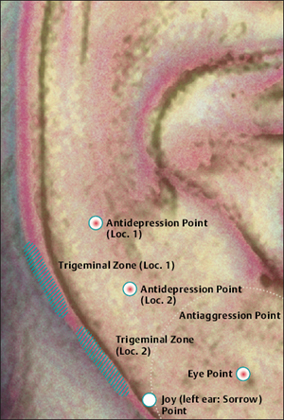
 Here, combination with body acupuncture has in particular proved its worth. A basic formula in the treatment of pollinosis via body acupuncture are the points LI-4, LI-11, Ex-HN-1, BL-2, LI-20.
Here, combination with body acupuncture has in particular proved its worth. A basic formula in the treatment of pollinosis via body acupuncture are the points LI-4, LI-11, Ex-HN-1, BL-2, LI-20.
 Retuning of the immune system as part of the treatment of pollinosis is useful. This can be done with small amounts of the patient’s own blood (up to 0.5 mL). The addition of a homeopathic retuning remedy such as Formic Acid D 6 has also proved worthwhile.
Retuning of the immune system as part of the treatment of pollinosis is useful. This can be done with small amounts of the patient’s own blood (up to 0.5 mL). The addition of a homeopathic retuning remedy such as Formic Acid D 6 has also proved worthwhile.
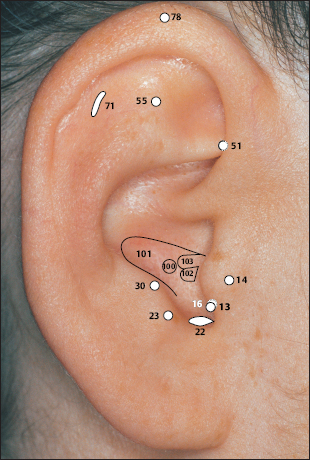

 The irritated vertebral segment located in the region of the Cervical Vertebrae Zone (CVZ), the Thoracic Vertebrae Zone (TVZ) or–seldom–the LVZ should be included in the treatment.
The irritated vertebral segment located in the region of the Cervical Vertebrae Zone (CVZ), the Thoracic Vertebrae Zone (TVZ) or–seldom–the LVZ should be included in the treatment.
 We find the irritated segment with the aid of the point searching device or the anatomical condition (scaling, pressure sensitivity, etc.). Based on this, additional treatment points can be found (cf. p. 30).
We find the irritated segment with the aid of the point searching device or the anatomical condition (scaling, pressure sensitivity, etc.). Based on this, additional treatment points can be found (cf. p. 30).
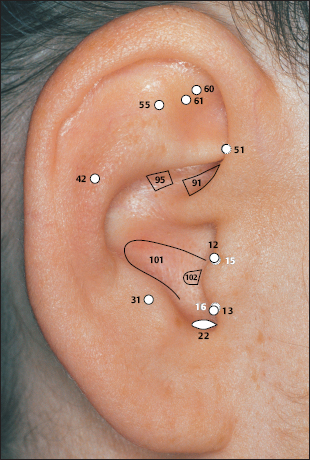
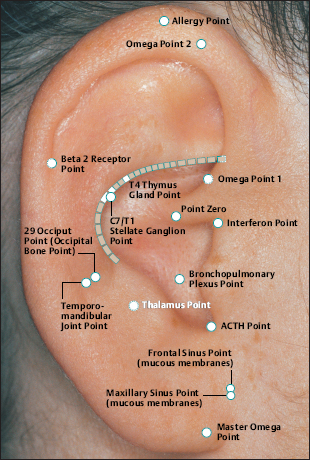
 According to Nogier, blood pressure is reduced by means of a gold needle and raised by means of a silver needle.
According to Nogier, blood pressure is reduced by means of a gold needle and raised by means of a silver needle.
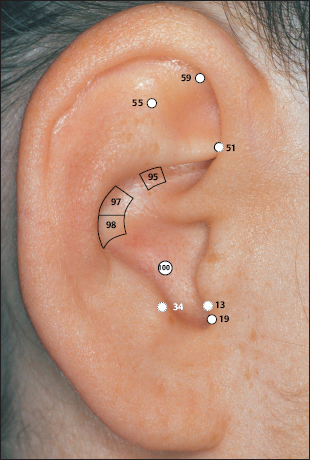

 Life-threatening diseases represent a contraindication for acupuncture. In diseases such as, for example, malignant heart rhythm disturbances or angina pectoris, acupuncture can only provide support.
Life-threatening diseases represent a contraindication for acupuncture. In diseases such as, for example, malignant heart rhythm disturbances or angina pectoris, acupuncture can only provide support.
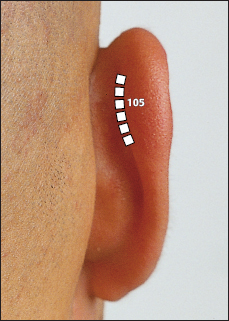
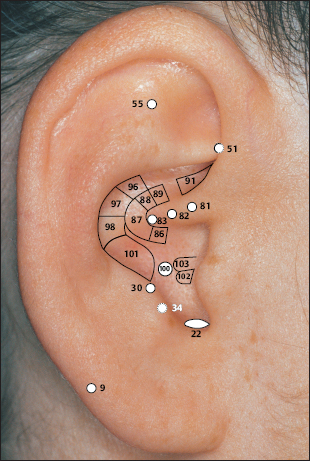
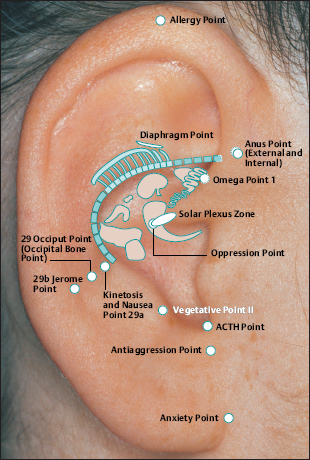

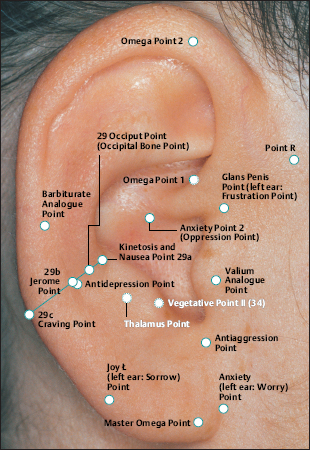
 According to Nogier, affecting the homolateral side of the body.
According to Nogier, affecting the homolateral side of the body.
 Caution: Contraindicated during pregnancy.
Caution: Contraindicated during pregnancy.
 Nogier locates the Occiput Point in the postantitragal fossa, in the left between Point 29a and Point 29b.
Nogier locates the Occiput Point in the postantitragal fossa, in the left between Point 29a and Point 29b.
 Anxiety: Treatment via the right ear (silver needle);
Anxiety: Treatment via the right ear (silver needle);
 Worry: Treatment via the left ear (silver needle).
Worry: Treatment via the left ear (silver needle).
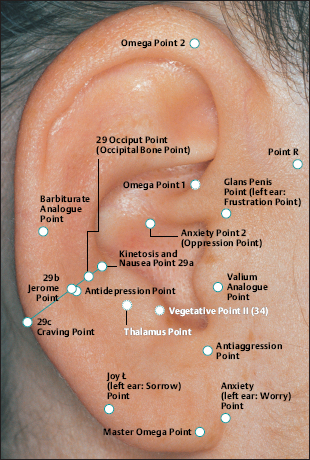
 In case of articular rheumatism: use gold needles.
In case of articular rheumatism: use gold needles.
 Caution: Contraindicated during pregnancy.
Caution: Contraindicated during pregnancy.
 The indication of Point 24a and Point 24b is specified for all non-inflammatory diseases of the eye. In China diseases such as myopia, astigmatism, and opticus atrophy are treated via these points.
The indication of Point 24a and Point 24b is specified for all non-inflammatory diseases of the eye. In China diseases such as myopia, astigmatism, and opticus atrophy are treated via these points.
 According to the traditional Chinese school, the liver is linked to the eye (cf. Five Elements). Thus, Point 97 (Liver Zone) is often needled as well in the case of non-inflammatory eye diseases.
According to the traditional Chinese school, the liver is linked to the eye (cf. Five Elements). Thus, Point 97 (Liver Zone) is often needled as well in the case of non-inflammatory eye diseases.

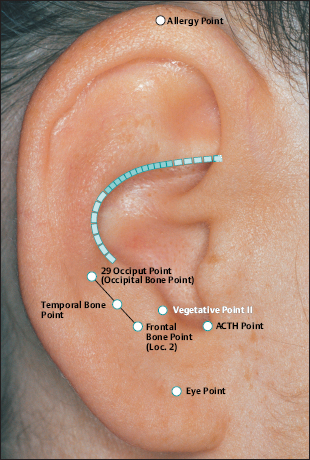
 Here combination with other somatopes has proved worthwhile, e.g. oral acupuncture and new pain and organ treatment via points. Diagnosis of the field of disturbance plays an important part.
Here combination with other somatopes has proved worthwhile, e.g. oral acupuncture and new pain and organ treatment via points. Diagnosis of the field of disturbance plays an important part.
 The Vertigo Line according to von Steinburg is the horizontal line which runs from Point 25 (cf. p. 54) along the upper edge of the antitragus. It is located slightly more to the inside.
The Vertigo Line according to von Steinburg is the horizontal line which runs from Point 25 (cf. p. 54) along the upper edge of the antitragus. It is located slightly more to the inside.
 The vertical line runs along the postantitragal fossa to the helical groove in accordance with the line of Points 29a, 29, and 29b.
The vertical line runs along the postantitragal fossa to the helical groove in accordance with the line of Points 29a, 29, and 29b.
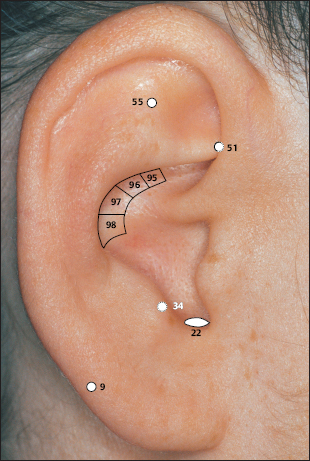
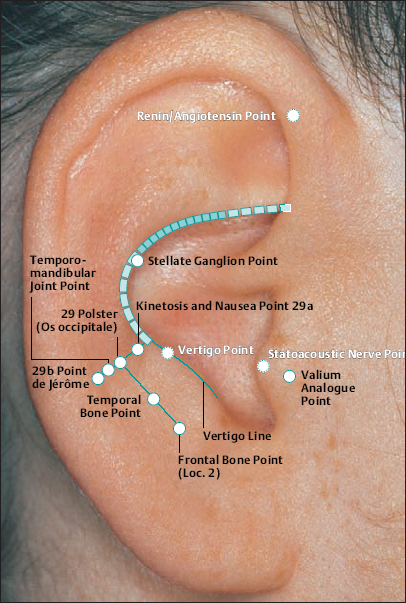
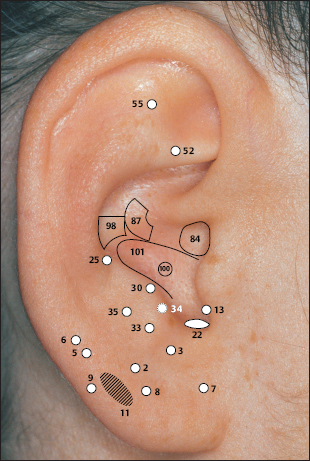
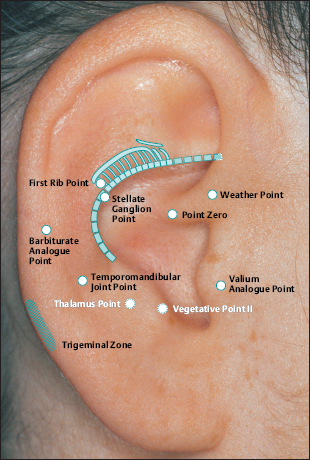
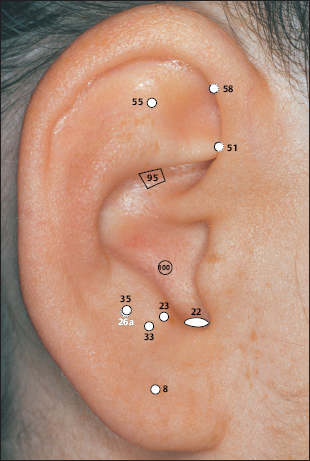
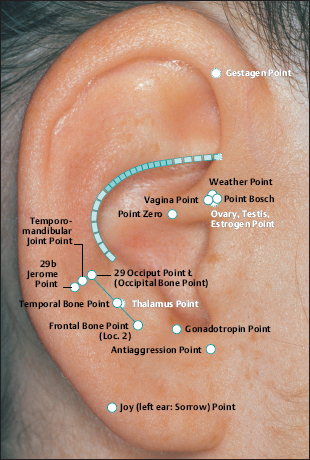
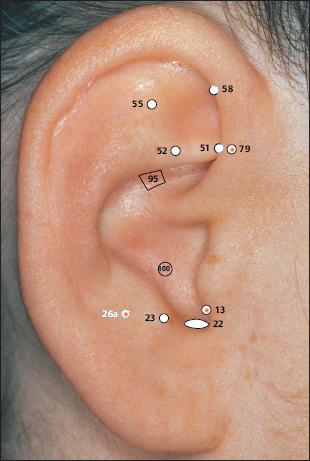
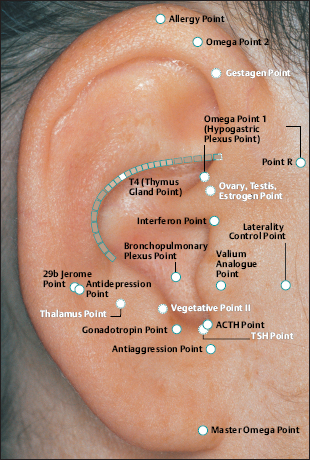
 In cases of aggression, hot flushes, and intermittent sweating and agitation in addition: Antiaggression Point Vegetative Points I and II
In cases of aggression, hot flushes, and intermittent sweating and agitation in addition: Antiaggression Point Vegetative Points I and II
 In case of insomnia also: Jerome Point Valium Analogue Point
In case of insomnia also: Jerome Point Valium Analogue Point
 In case of depressive moods also: Antidepression Point
In case of depressive moods also: Antidepression Point
 In case of laser treatment also: Bronchopulmonary Plexus Point Point R (according to R.J. Bourdiol)
In case of laser treatment also: Bronchopulmonary Plexus Point Point R (according to R.J. Bourdiol)
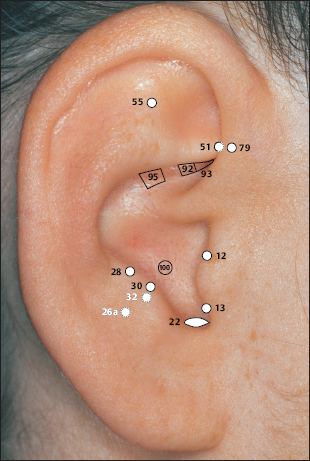

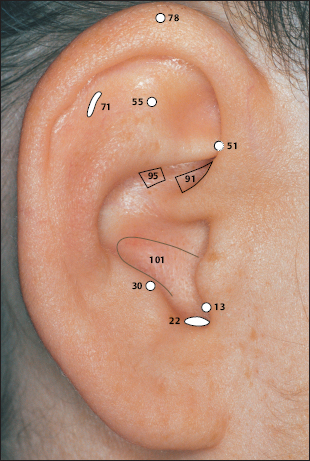

Stay updated, free articles. Join our Telegram channel

Full access? Get Clinical Tree






